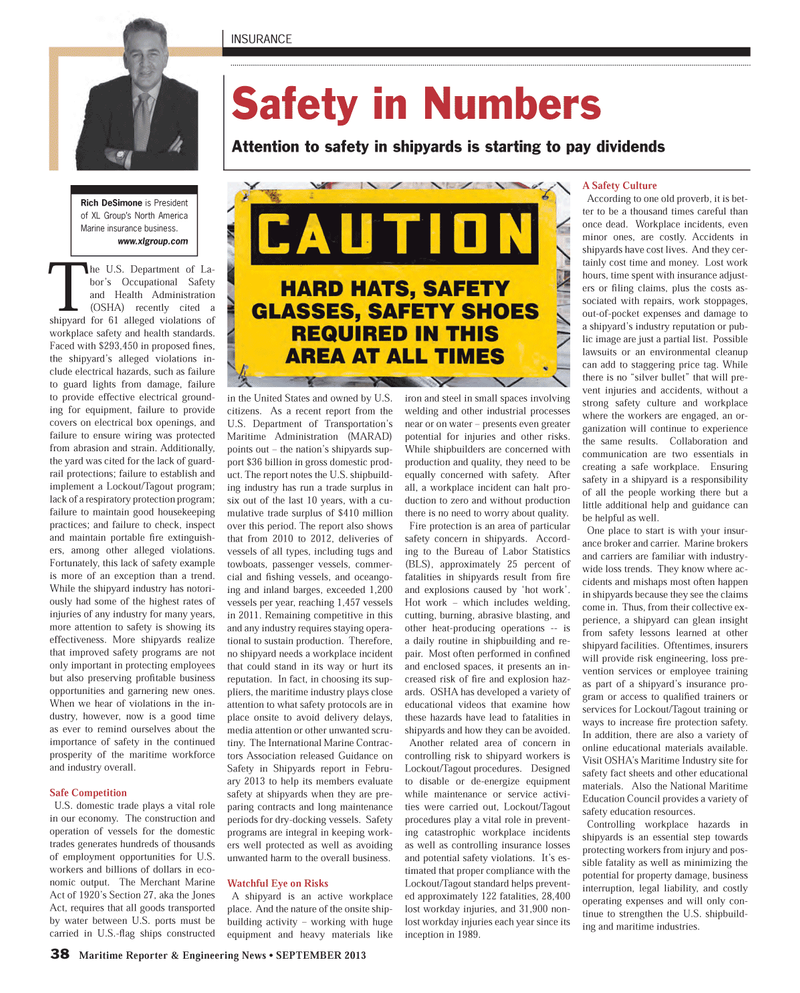
Page 38: of Maritime Reporter Magazine (September 2013)
Workboat Annual
Read this page in Pdf, Flash or Html5 edition of September 2013 Maritime Reporter Magazine
38 Maritime Reporter & Engineering News ? SEPTEMBER 2013 The U.S. Department of La-bor?s Occupational Safety and Health Administration (OSHA) recently cited a shipyard for 61 alleged violations of workplace safety and health standards. Faced with $293,450 in proposed Þ nes, the shipyard?s alleged violations in- clude electrical hazards, such as failure to guard lights from damage, failure to provide effective electrical ground- ing for equipment, failure to provide covers on electrical box openings, and failure to ensure wiring was protected from abrasion and strain. Additionally, the yard was cited for the lack of guard-rail protections; failure to establish and implement a Lockout/Tagout program; lack of a respiratory protection program; failure to maintain good housekeeping practices; and failure to check, inspect and maintain portable Þ re extinguish- ers, among other alleged violations. Fortunately, this lack of safety example is more of an exception than a trend. While the shipyard industry has notori-ously had some of the highest rates of injuries of any industry for many years, more attention to safety is showing its effectiveness. More shipyards realize that improved safety programs are not only important in protecting employees but also preserving proÞ table business opportunities and garnering new ones. When we hear of violations in the in-dustry, however, now is a good time as ever to remind ourselves about the importance of safety in the continued prosperity of the maritime workforce and industry overall.Safe CompetitionU.S. domestic trade plays a vital role in our economy. The construction and operation of vessels for the domestic trades generates hundreds of thousands of employment opportunities for U.S. workers and billions of dollars in eco-nomic output. The Merchant Marine Act of 1920?s Section 27, aka the Jones Act, requires that all goods transported by water between U.S. ports must be carried in U.S.-ß ag ships constructed in the United States and owned by U.S. citizens. As a recent report from the U.S. Department of Transportation?s Maritime Administration (MARAD) points out ? the nation?s shipyards sup- port $36 billion in gross domestic prod-uct. The report notes the U.S. shipbuild- ing industry has run a trade surplus in six out of the last 10 years, with a cu-mulative trade surplus of $410 million over this period. The report also shows that from 2010 to 2012, deliveries of vessels of all types, including tugs and towboats, passenger vessels, commer- cial and Þ shing vessels, and oceango- ing and inland barges, exceeded 1,200 vessels per year, reaching 1,457 vessels in 2011. Remaining competitive in this and any industry requires staying opera-tional to sustain production. Therefore, no shipyard needs a workplace incident that could stand in its way or hurt its reputation. In fact, in choosing its sup-pliers, the maritime industry plays close attention to what safety protocols are in place onsite to avoid delivery delays, media attention or other unwanted scru-tiny. The International Marine Contrac- tors Association released Guidance on Safety in Shipyards report in Febru-ary 2013 to help its members evaluate safety at shipyards when they are pre-paring contracts and long maintenance periods for dry-docking vessels. Safety programs are integral in keeping work-ers well protected as well as avoiding unwanted harm to the overall business. Watchful Eye on Risks A shipyard is an active workplace place. And the nature of the onsite ship-building activity ? working with huge equipment and heavy materials like iron and steel in small spaces involving welding and other industrial processes near or on water ? presents even greater potential for injuries and other risks. While shipbuilders are concerned with production and quality, they need to be equally concerned with safety. After all, a workplace incident can halt pro-duction to zero and without production there is no need to worry about quality. Fire protection is an area of particular safety concern in shipyards. Accord- ing to the Bureau of Labor Statistics (BLS), approximately 25 percent of fatalities in shipyards result from Þ re and explosions caused by ?hot work?. Hot work ? which includes welding, cutting, burning, abrasive blasting, and other heat-producing operations -- is a daily routine in shipbuilding and re-pair. Most often performed in con Þ ned and enclosed spaces, it presents an in-creased risk of Þ re and explosion haz- ards. OSHA has developed a variety of educational videos that examine how these hazards have lead to fatalities in shipyards and how they can be avoided. Another related area of concern in controlling risk to shipyard workers is Lockout/Tagout procedures. Designed to disable or de-energize equipment while maintenance or service activi-ties were carried out, Lockout/Tagout procedures play a vital role in prevent-ing catastrophic workplace incidents as well as controlling insurance losses and potential safety violations. It?s es- timated that proper compliance with the Lockout/Tagout standard helps prevent- ed approximately 122 fatalities, 28,400 lost workday injuries, and 31,900 non-lost workday injuries each year since its inception in 1989.A Safety Culture According to one old proverb, it is bet-ter to be a thousand times careful than once dead. Workplace incidents, even minor ones, are costly. Accidents in shipyards have cost lives. And they cer- tainly cost time and money. Lost work hours, time spent with insurance adjust-ers or Þ ling claims, plus the costs as- sociated with repairs, work stoppages, out-of-pocket expenses and damage to a shipyard?s industry reputation or pub- lic image are just a partial list. Possible lawsuits or an environmental cleanup can add to staggering price tag. While there is no ?silver bullet? that will pre-vent injuries and accidents, without a strong safety culture and workplace where the workers are engaged, an or- ganization will continue to experience the same results. Collaboration and communication are two essentials in creating a safe workplace. Ensuring safety in a shipyard is a responsibility of all the people working there but a little additional help and guidance can be helpful as well. One place to start is with your insur- ance broker and carrier. Marine brokers and carriers are familiar with industry-wide loss trends. They know where ac- cidents and mishaps most often happen in shipyards because they see the claims come in. Thus, from their collective ex- perience, a shipyard can glean insight from safety lessons learned at other shipyard facilities. Oftentimes, insurers will provide risk engineering, loss pre-vention services or employee training as part of a shipyard?s insurance pro- gram or access to qualiÞ ed trainers or services for Lockout/Tagout training or ways to increase Þ re protection safety. In addition, there are also a variety of online educational materials available. Visit OSHA?s Maritime Industry site for safety fact sheets and other educational materials. Also the National Maritime Education Council provides a variety of safety education resources. Controlling workplace hazards in shipyards is an essential step towards protecting workers from injury and pos-sible fatality as well as minimizing the potential for property damage, business interruption, legal liability, and costly operating expenses and will only con-tinue to strengthen the U.S. shipbuild-ing and maritime industries. INSURANCESafety in NumbersAttention to safety in shipyards is starting to pay dividends Rich DeSimone is President of XL Group?s North America Marine insurance business. www.xlgroup.com MR #9 (34-41).indd 38MR #9 (34-41).indd 389/4/2013 4:39:23 PM9/4/2013 4:39:23 PM

 37
37

 39
39
